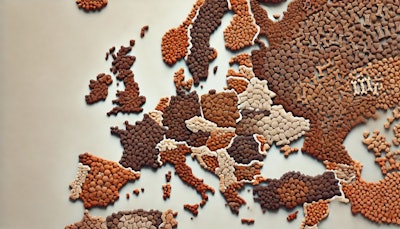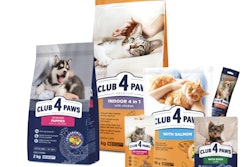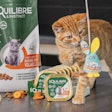
The 10 pet food companies listed in the chart below were part of the growing European industry in 2024 from Petfood Industry’s Top Pet Food Companies database. More than 60% of pet food industry mergers and acquisitions in 2024 involved European companies, outpacing the U.S., reported Petfood Industry.
Companies not currently featured in our online database, or those seeking to update or correct existing information, can contact us at [email protected].
Although 2024 data for the European pet food market is not yet available, the total value of the European pet food market in 2023 reached EUR29.3 billion (US$33.7 billion), growing 9%. That revenue grew from selling 9.1 million metric tonnes (10.03 tons) of pet food and treats. From Albania to the United Kingdom, more than 400 pet food companies produced that food in at least 500 facilities. The Fédération Européenne de l'Industrie des Aliments pour Animaux Familiers (FEDIAF, European Pet Food Industry Federation) released that data in their 2025 Facts and Figures report. Tim Wall using DALL-E
Tim Wall using DALL-E
Pet ownership growing in Europe
FEDIAF data also reflected a rising pet ownership in Europe. In 2023, 139 million European households included a pet of some kind, accounting for 299 million individual animals. That’s equivalent to 49% of European households. Cats were the most populous, occupying 26% of European homes. In Europe, 108 million cats live as people’s pets.
Dogs dwelt in 25% of European domiciles. With a population of 90 million in 2023, dogs were the second most common companion animal.
Ornamental birds rounded out the top three pets with 48 million feathered friends, followed by 25 million small mammals, 18 million fish and other aquarium occupants. Reptiles, amphibians, arthropods and other terrarium tenants finished the list with 11 million.
Country‑level per capita ownership reveals nuanced patterns:
- Dogs: Poland led with a 22.9% dog‑to‑human ratio, followed by Spain at 19.7%, with Germany and the United Kingdom having lower per‑capita rates despite higher absolute numbers. France had the lowest dog per‑capita ratio at 11.1 percent, despite maintaining 7.6 million dogs.
- Cats: France registered the highest per‑capita cat‑ownership rate at 21.8%, with Poland close behind at 20.5%. Germany led in absolute numbers (15.7 million cats), yet held a mid‑range per‑capita figure of 18.6 percent; the United Kingdom and Italy followed with 16.7% and 17.4%, respectively. Spain recorded the lowest per‑capita cat ownership at 12.4%.
With a growing pet population and robust business environment, European pet food companies may continue growing in 2025 despite tariffs, military conflicts and other macroeconomic challenges.















